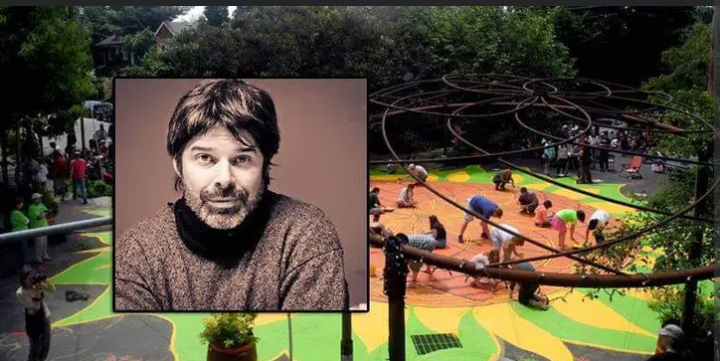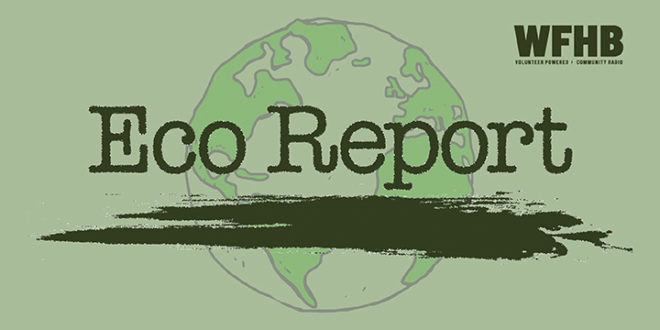Podcast: Play in new window | Download (Duration: 31:00 — 42.6MB)
Subscribe: RSS
| Hello and welcome to Eco-Report. For WFHB, I’m Julianna Dailey. And I’m Frank Marshalek. Later on in the program, Environmental Correspondent Zyro Roze explores urban permaculture and village building with Mark Lakeman, the eco architect and place maker behind Portland Oregon’s City Repair Project, which has inspired communities around the world to transform their neighborhoods into art installations and food forests.
|
|
And now for your environmental reports: Inside Climate Change reports on the status of a plastics recycling plant in Ashley, Indiana. EcoReport has covered progress at the huge facility earlier and emphasized the dangers posed by this facility. Companies outside Indiana place their dirty plants here because our politicians tolerate pollution. Inside Indiana’s ‘Advanced’ Plastics Recycling Plant there are dangerous vapors, oil spills and life-threatening fires. The Brightmark “plastics renewal” plant can’t get past the startup phase, as former employees raise environmental, health and safety concerns. The plant’s owner is San Francisco-based Brightmark. The plan here is to store, shred and chop plastic waste and extrude it into pellets. Those pellets are then fed into pressurized “pyrolysis” chambers—the plant has six of them—that use extreme heat to produce a synthetic gas and a dirty “pyrolysis oil,” in what the chemical industry markets as a type of “advanced recycling.” The plastics industry champions the process as something that makes plastics sustainable, even green, by turning old plastic containers, packaging and the like into new plastic products without the need to extract more fossil fuels to create new plastic feedstocks. But many scientists and environmentalists say pyrolysis is anything but sustainable, describing it as energy-intensive manufacturing with a large carbon footprint that incinerates much of the plastic waste and mostly just makes new fossil fuels. A fire in May of 2021 is just one of several environmental health or safety challenges the company has faced since it began testing its plant in 2020 while struggling to fulfill its promise of operating “the world’s largest plastics renewal facility” on a commercial scale. The plant has kept the Ashley Fire Department of about 20 members busy, responding to at least six or seven fires since 2020, at least one producing a plume of smoke that could be seen 35 miles away in Fort Wayne. They remind us of the plastics fire in Richmond. EcoReport has raised another potential issue: what’s in the emissions. This type of process often generates dioxins, which are carcinogenic. These compounds can be eliminated by adding additional combustion of the emission gases. EcoReport has not been able to learn the details of emissions —Norm Holy |
| Inside Indiana Business reports that by the time it’s expected to come online in 2026, a West Terre Haute-based fertilizer plant will have the capacity to capture and store as much as 1.65 million tons of carbon dioxide annually, making it one of the largest carbon-sequestration projects in the country.
Wabash Valley Resources, which was formed in 2016 to acquire a shuttered Duke Energy coal plant in Vigo County, is moving forward with the project after state lawmakers passed legislation requiring the company to compensate landowners for the porous, underground rock formations underneath their property that will hold carbon dioxide. The plant currently produces hydrogen-rich syngas, but the company plans to retrofit the facility to also produce anhydrous ammonia fertilizer and separate CO2 for sequestration. “This is a billion-dollar asset that we’re repurposing to make fertilizer and, maybe down the road, hydrogen,” said Sen. Jon Ford, a Republican from Terre Haute who supports the development. “I think there’s a lot of possibilities with a project like this.” The $900 million endeavor, which has received funding from Arizona-based battery manufacturer Nikola Corp. as well as the U.S. Department of Energy’s Carbon Storage Program, will address a high demand for a reliable supply of agricultural ammonia used for crops such as corn and wheat without harming air quality, company officials say. “Both the Department of Energy and the Environmental Protection Agency are very excited about us doing this at scale because it’s the path forward to avoid the kind of air pollution that comes from the burning of carbon,” said Greg Zoeller, vice president of external affairs for Wabash Valley Resources. While carbon-capture technology has the support of the Biden administration and EPA officials, some environmental advocates and consumer protection groups caution that the process does not come without risk, pointing to an incident in Mississippi in February 2020 when a CO2 pipeline burst, resulting in 45 people being hospitalized. “It’s a completely unproven technology that we are pushing forward based on extreme and extraordinary lobbying done by the fossil-fuel industry,” said Kerwin Olson, executive director of the Indianapolis-based Citizens Action Coalition. That is the correct assessment. —Norm Holy |
| It is rare these days to see frogs or toads on our properties. Melinda Myers, horticulturist and gardening expert, offers tips to make your outdoor space more attractive. Toads and frogs make great gardening partners. They eat lots of insects, including mosquitoes, slugs, and snails, and ask for very little in return. Help attract these natural predators to your garden with just a few changes in your gardening habits.
Their thin permeable skin allows toxins and pollutants to pass through and enter their bodies. These chemicals can disrupt development, reproduction and even kill these creatures. This is why they are considered an indicator of environmental health. So skip the pesticides to help keep them safe and enlist other strategies when needed to manage weeds, diseases, and insect pests in the garden. And if you already have frogs and toads in your yard you may only need to make a few minor changes to attract even more. Relax your garden cleanup routine. A tidy garden is not where toads and frogs prefer to live. Leave some leaf litter under trees and shrubs and in the garden. This natural mulch provides a cool damp environment perfect for them. It also helps conserve moisture, suppresses weeds, and improves the soil as the leaves decompose. All this is good for the health of your plants and means less maintenance for you. Create dense plantings of native perennials and grasses that provide shady hideouts and great hunting grounds for these amphibians. They will find insects, worms, slugs, snails, and more to dine upon in these lush locations. Include some night-blooming fragrant plants to help attract night-flying moths. You’ll provide food for the toads and frogs’ night hunts and fragrances for you to enjoy. —Norm Holy |
| Paul A. Smith (Wildlife Research Division, Environment and Climate Change Canada), and a large number of coauthors published a paper (Ornithological Applications ) this year about the disappearing shore birds in North America. Shorebirds are declining to a greater extent than many other avian taxa around the world. In North America, shorebirds, along with aerial insectivores (e.g., swifts, swallows, and martins) and grassland birds, have some of the highest proportions of declining species of any group.
• Surveys of North American shorebirds during fall migration, carried out largely by volunteers, are used to monitor trends in the abundance of their populations. • Between 1980 and 2019, 26 of the 28 shorebird species analyzed were found to be declining with more than half of the species losing more than half of their abundance. • Declines were greatest along the Atlantic coast from Nova Scotia to North Carolina, and less severe along the Gulf coast and in the Midcontinent. • Declines are worsening in recent years. These large and accelerating declines mean that many species now exceed international criteria for threatened species listing. • Urgent conservation action is needed to slow and eventually reverse declines. Targeted research, and in particular studies of survival throughout the year, could help to pinpoint where shorebirds are most strongly impacted, so that conservation attention can be focused where it is most needed. One thing is clear about Indiana: the legislature has little regard for shore birds. The legislature has removed very large acreage from wetland protection. They cater to builders who want to build on cheap land. —Norm Holy |
| The Department of Agriculture gives tens of millions of dollars every year to farmers and ranchers to support conservation efforts on their farms, but much of the funding ends up at big, industrial-scale operations that critics say worsen agricultural pollution and emit climate-warming greenhouse gases, a new report has found.
The report, released last week by the Institute for Agriculture and Trade Policy, concluded that one of the agency’s biggest and most popular conservation programs, the Environmental Quality Incentives Program, gave out its costliest grants in 2022 to seven large dairy farms in California, the country’s biggest dairy-producing state. These grants, nearly $300,000 each, were for construction of anaerobic digesters, which capture methane gas from lagoons where manure is collected. The methane is then converted into “biogas” that gets routed into pipelines to heat homes and buildings. —Norm Holy |
| And now, Zyro Roze speaks with Mark Lakeman, Lead Architect of Communitecture, on how grassroots activism is making neighborhoods safer, more fun and ecologically sustainable. |

| For Eco-Report, I am Julianna Dailey. And, I am Frank Marshalek.Are you looking for a way to make a difference on environmental issues? Here at EcoReport we are currently looking for reporters, engineers, and segment producers. Our goal is to report facts on how we’re all affected by global climate disruption and the ongoing assaults on our air, land and water. We also celebrate ecologists, tree huggers, soil builders and an assortment of champions who actively protect and restore our natural world, particularly those who are active in south central Indiana.
All levels of experience and all ages are welcome, and we provide the training you’ll need. W-F-H-B also offers internships. To volunteer for Eco-Report, give us a call at (812) 323-1200, or e-mail us at: [email protected]. |
|
And now for some upcoming events: The Sassafras Audubon Society is sponsoring a Bird Hike at Pate Hollow on Tuesday, June 27th, from 8 to 11 am. You will be hiking the 3-mile Pate Hollow Trail with David Rupp of IndiGo Birding Nature Tours. Register at [email protected] or call 812-679-8978. |
| Join Daniel Layton with Sycamore Land Trust on Friday, June 30th, from 4 to 6 pm for a Wetland Flora Exploration Walk at the Beanblossom Bottoms Nature Preserve. You will be introduced to basic botany and wetland flora identification. |
| Goose Pond Fish and Wildlife Area is hosting a Bats & Brownies program in the Visitor Center on Friday, June 30th, from 8 to 10 pm. Learn all about bats while you eat yummy brownies. You will be outside for part of the evening to look for bats. |
| And that wraps up our show for this week. EcoReport is brought to you in part by M-P-I Solar, a Bloomington business specializing in solar hot water, solar electricity and solar hot air systems. M-P-I Solar designs and installs solar power generation systems that encourage independence and individual responsibility. Found locally at 812-334-4003 and on the Web at MPIsolarenergy.com. |
| This week’s headlines were written by Norm Holy. Today’s news feature was produced by Zyro Roze and edited by Noelle Herhusky-Schneider. Julianna Dailey assembled the script which was edited by Zyro Roze. Julianna Dailey compiled our events calendar. Kade Young and Noelle Herhusky-Schneider produced today’s show. Branden Blewett was our engineer. For WFHB, I’m Julianna Dailey. And I am Frank Marshalek. And this is EcoReport. |
 WFHB Bloomington Community Radio
WFHB Bloomington Community Radio


